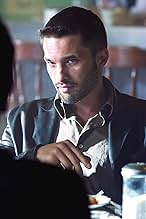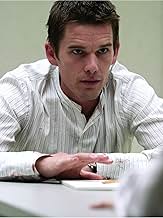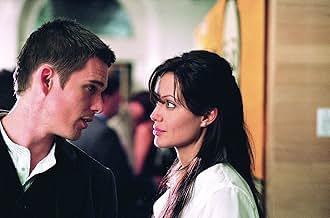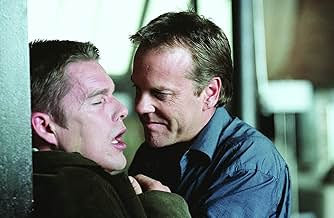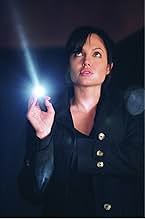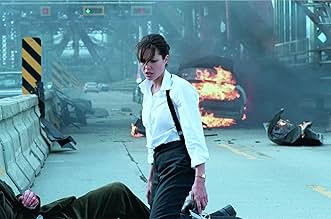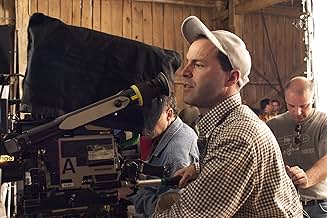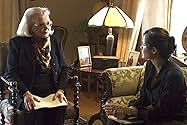Luego de una serie de asesinatos en los que el asesino toma la identidad de cada nueva víctima, la policía Franco-Canadiense debe llamar a un integrante del FBI para su detención.Luego de una serie de asesinatos en los que el asesino toma la identidad de cada nueva víctima, la policía Franco-Canadiense debe llamar a un integrante del FBI para su detención.Luego de una serie de asesinatos en los que el asesino toma la identidad de cada nueva víctima, la policía Franco-Canadiense debe llamar a un integrante del FBI para su detención.
- Premios
- 4 nominaciones en total
Argumento
¿Sabías que…?
- TriviaA scene was shot in which Illeana drives back to her house with the old pick-up and a branch from a tree falls and breaks the windshield. It took several takes to get the shot, and apparently destroyed the last remaining windshields for the pick-up available anywhere in North America at the time. The scene was not used.
- ErroresThe three lead police investigators all speak with Parisian French accents. Quebec French is as distinct from Parisian French as British English is distinct from New York English.
- Citas
Martin Asher: That guy was nothing, alright? I didn't take his life, I lived it. I was the best thing that ever happened to that guy. You looked at him, and you saw me, and I looked at you, and I saw you, and we are the same.
- Versiones alternativasAvailable in both its R-rated theatrical version (103 min.) and in an unrated director's cut (109 min.).
The movie begins with an intriguingly stylized prologue that shows the young teenage killer on his maiden voyage. He has probably already killed his twin brother. Now he has hit the road armed with a big wad of cash acquired by selling his mother's stolen jewelry, though we don't know all that till later. All we see is a sly, strange boy who meets another youth on a bus, hears his life story, and when the bus gets stuck on the highway, buys a cheap used car for them to continue traveling in. While they're fixing a flat, he pushes his traveling companion in front of a passing truck and his life of murderous identity theft begins.
The staging of this segment is edgy, the lighting baroque, the boys and the landscape vivid. While the filmmakers have our attention they create an original atmosphere that's not ever quite equaled when the story skips forward to the present.
For those of us weaned on Miss Marple, it's a bit of a shock to have a head dick as distractingly pretty as Angelina Jolie, she of the lips. Whether this was a smart career choice for Ms. Jolie is debatable. She works hard to be convincing. Another wrinkle - hardly a new one, though - is that once the killer has been `made', he constantly points out his similarities with her. She's FBI, but she's as focused on killing as he is. She dines and sleeps with photos of bashed heads and lopped limbs perched in front of her: she's a bit ghoulish in her obsession with her work. But serial killers and their chief investigators always bond, if we're to go by the Hannibal Lector stories.
Iliana (Jolie) has been called in by French Canadian homicide detectives, one of whom, Olivier Martinez, has lips as voluptuous as hers. His boss, Tchéky Karyo, is suave and European; but the best of the three, Jean-Hugues Anglade, is merely beat-up looking and real. It's another minor twist that this movie was not only shot in Canada, but is actually set there, though the filmmakers insist on perversely saying it's Montreal, while constantly showing views of Quebec City as establishing shots. All three French actors speak an English that's hard to understand. I could have done without Martinez's glam looks in favor of someone with clearer diction. His mumbles may have worked for him as Diane Lane's Euro-hunk lover in Unfaithful, but for a police procedural, they don't.
As time goes on the baroque cinematography, which casts three quarters of every scene in deep shadow, begins to be as murky as the staccato Frenchified dialogue. Nonetheless the movie is stylish and watchable, up to a point. Ethan Hawke appears as a nervous witness who tries to save one of the murder victims and makes a drawing of the killer. His role evolves into one of the edgiest things he's done. Already ravaged and gaunt from his impending breakup with Uma, poor chap, he gives this his tortured all. It's been a long way from the bland schoolboy role in Dead Poets Society that first brought him notice. Kiefer Sutherland does a turn that has become a cliché for him. The obvious surprises nonetheless still seem surprising, though the finale is pure camp, shameful really. A sudden car chase is irritating and unnecessary, though happily brief.
Since we began with a close look at the killer, throughout the rest we miss his point of view. Even when we get close to him we're teased into thinking we don't know who he is. The audience is left longing for a more intimate picture of the criminal psychopathic mind (à la Highsmith), the sort of thing that the flashback opening sequence hinted at. Throughout one feels that director Caruso is reaching for something a little bit original. He even has a score by Philip Glass, which used to be a distinction. It hardly is any more. There are three movies with Glass music showing right now: this, Secret Window, and The Fog of War. Taking Lives has been widely reviled by critics whose impatience with the genre makes them overlook the fact that it's really a bit above average - if we ignore the crappy final scene.
- Chris Knipp
- 22 mar 2004
- Enlace permanente
Selecciones populares
Detalles
- Fecha de lanzamiento
- País de origen
- Sitio oficial
- Idiomas
- También se conoce como
- Taking Lives
- Locaciones de filmación
- Productoras
- Ver más créditos de la compañía en IMDbPro
Taquilla
- Presupuesto
- USD 45,000,000 (estimado)
- Total en EE. UU. y Canadá
- USD 32,682,342
- Fin de semana de estreno en EE. UU. y Canadá
- USD 11,458,465
- 21 mar 2004
- Total a nivel mundial
- USD 65,470,529
- Tiempo de ejecución1 hora 43 minutos
- Color
- Mezcla de sonido
- Relación de aspecto
- 2.35 : 1
Contribuir a esta página








